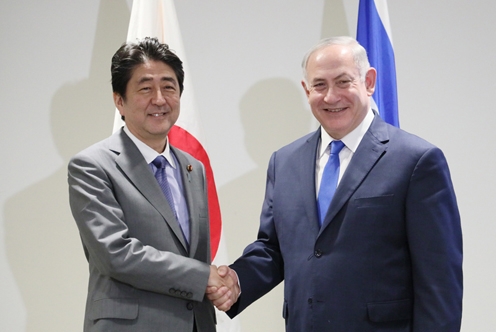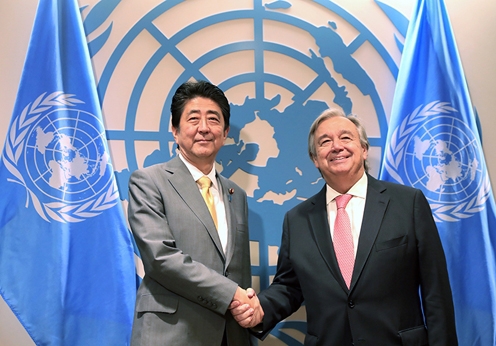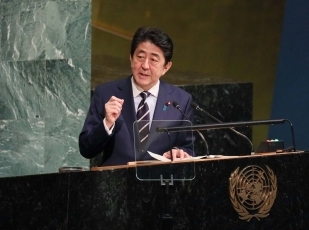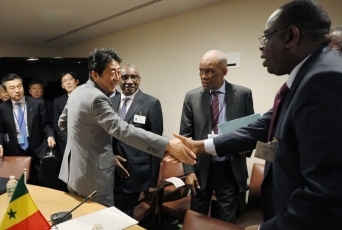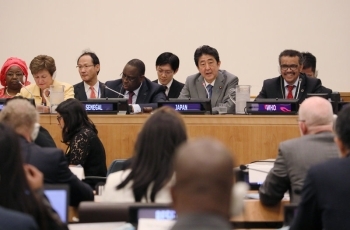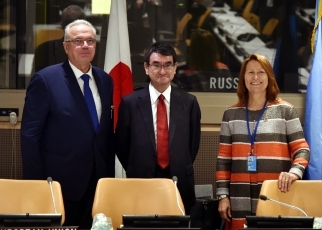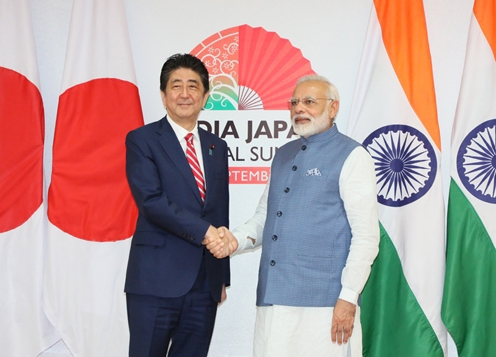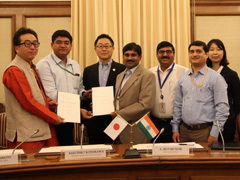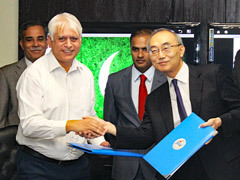Visit to the United States: First Day
Cabinet Secretariat, Tuesday, September 19, 2017
[Provisional Translation]
On September 18, 2017 (local time), Prime Minister Shinzo Abe visited New York in the United States of America.
The Prime Minister attended the event, “World Leaders for Universal Health Coverage (UHC): A High-Level Discussion at the United Nations on Achieving the SDGs through Health for All” and a meeting with the leaders of the African members of the United Nations Security Council and other African leaders. Afterwards, the Prime Minister held talks with H.E. Mr. Benjamin Netanyahu, Prime Minister of the State of Israel.
In the evening, the Prime Minister attended the Food and Tourism Reception.
Visit to the United States: Second Day
Cabinet Secretariat, Tuesday, September 19, 2017
[Provisional Translation]
On September 19 (local time), Prime Minister Shinzo Abe, who is currently visiting New York in the United States of America in order to attend the United Nations General Assembly and for other matters, attended a meeting with US CEOs.
Following this, the Prime Minister held talks with H.E. Dr. Hassan Rouhani, President of the Islamic Republic of Iran; Mr. António Guterres, Secretary-General of the United Nations; and His Majesty King Abdullah II Ibn Al Hussein, King of the Hashemite Kingdom of Jordan; and then attended a luncheon hosted by United Nations Secretary-General Guterres.
In the evening, Prime Minister Abe attended the Fourth Japan-Pacific Islands Leaders Meeting.
Address by Prime Minister Shinzo Abe at the Seventy-Second Session of the United Nations General Assembly
Foreign Affairs, Wednesday, September 20, 2017
1.
Mr. President, ladies and gentlemen,
Today, I had intended first of all to tell you of the sincerity with which Japan is implementing the SDGs. I also had hoped to introduce to you the innovative ways by which we have been fostering public awareness within Japan towards those goals.
I wanted to tell you why the Women Entrepreneurs Finance Initiative, or “We-Fi,” is important to me personally as well as to the Government of Japan.
I have been saying we will make universal health coverage part of the “Japan brand.” We will hold a major conference this December in Tokyo taking up UHC as the theme.
The list of things I would have liked to raise here is long indeed -- our contributions towards the rule of law; our determination to undertake the Paris Agreement in a steadfast manner; our policy of addressing global infrastructure demand through quality investments.
Moreover, what Japan wants to safeguard in every respect is the free, liberal, open international order and multilateral frameworks.
The world certainly holds high expectations towards the UN as the flagbearer upholding these. That is exactly why the Security Council should be reformed without delay, in response to the demands of the times.
Japan will strive together with its friends to achieve these reforms. I had intended to state that Japan’s abiding determination is to play an active role for world peace as a permanent member of the Security Council.
However, I have no choice but to focus my remarks on a single issue, that of North Korea.
2.
North Korea conducted a nuclear test on September the 3rd. Whether or not it was a hydrogen bomb test, its scale far exceeded that of previous tests.
Both before and after that, on August 29, and again on September 15 before the ink on Resolution 2375, passed by the Security Council to impose sanctions on North Korea, was even dry, North Korea launched missiles.
Both of these were launched to fly over Japan and make a display of their cruising range.
The gravity of this threat is unprecedented. It is indisputably a matter of urgency.
North Korea is attempting to dismiss with a smirk the efforts towards disarmament we have assiduously undertaken over the years.
The non-proliferation regime is about to suffer a serious blow from its most confident disrupter ever.
Mr. President, distinguished colleagues,
This recent crisis is of an altogether different dimension qualitatively than those we have eluded every time some dictator has attempted to acquire weapons of mass destruction.
North Korea’s nuclear weapons either already are, or are on the verge of becoming, hydrogen bombs.
Their means of delivery will sooner or later be ICBMs.
Over the more than 20 years since the end of the Cold War, where and when else, and to what dictators, have we allowed such self-indulgence? As it turns out, it is only towards North Korea that this has been allowed.
That is the reality we find before us.
And, it was absolutely not a lack of dialogue that gave rise to this situation.
3.
Dialogue dissuaded North Korea from pursuing its nuclear ambitions. Dialogue has afforded many of us the relief that the world had been saved from a crisis. Believing thus, many of us have felt relieved, well, not just once, but twice.
The first time was in the early 1990s.
At the time, the threat that North Korea imposed amounted to little more than openly displaying its withdrawal from the IAEA and other inspection regimes.
However, tensions were felt by those of us who surmised the intent of that.
After many twists and turns, in October 1994, what is known as the “Agreed Framework” was realized between the U.S. and North Korea.
Under the framework, North Korea would be made to abandon its nuclear plans. In exchange, we would provide incentives to North Korea.
Towards that end, Japan, the U.S., and the ROK formed the Korean Peninsula Energy Development Organization, or “KEDO,” in March the following year.
Taking KEDO as the implementing agent, we pledged to build and hand over two light-water reactors (LWRs) to North Korea and also provide 500 thousand tons of heavy fuel oil annually as a stopgap measure for its energy demand.
This was all carried out accordingly. However, as time went by, it came to be known that North Korea had been continuing steadily with its uranium enrichment.
From the start, North Korea had never intended to abandon its nuclear ambitions. This had become readily apparent to all.
After 2002, seven years after it was founded, KEDO suspended its operations.
During that period, it can be said that North Korea defrauded the U.S., the ROK, and Japan of assistance.
Countries that recognized value in the KEDO framework of providing incentives to change North Korea’s actions gradually came to join KEDO -- the European Union, New Zealand, Australia, Canada, Indonesia, Chile, Argentina, Poland, the Czech Republic and Uzbekistan.
North Korea betrayed the good faith of all those KEDO members.
As one of the organization’s founding members, Japan had pledged to give a non-interest loan to KEDO and had fulfilled roughly 40 percent of that.
The pledged amount was 1 billion US dollars, with about 400 million fulfilled.
4.
The second crisis occurred in 2002 when KEDO suspended its operations and North Korea, saying it would end the freeze on its nuclear-related facilities, expelled IAEA inspectors.
The concern was again that North Korea was continuing its uranium enrichment. And again we chose the path of defusing the situation through dialogue.
North Korea, China, and Russia joined the three founding members of KEDO, Japan, the U.S., and the ROK, to launch the Six-Party Talks. That was in August 2003.
Subsequently, after two years of twists and turns, through the summer of 2005 into the fall, the Six Parties once reached an agreement, resulting in the release of a joint statement.
North Korea committed to abandoning all nuclear weapons and existing nuclear programs and returning to the NPT and to IAEA safeguards.
Moreover, two years after that, in February 2007, an agreement was concluded regarding what each of the Six Parties should do towards implementing the joint statement.
A group of IAEA inspectors that had entered North Korea verified the shutdown of the nuclear-related facilities in Yongbyon, and in return, North Korea received heavy fuel oil.
The series of events made people think that tenaciously continuing dialogue had this time finally caused North Korea to change its actions.
But what actually happened?
In February 2005, while the Six-Party Talks were underway, North Korea declared unilaterally that it was already in possession of nuclear weapons. Moreover, in October 2006, it openly carried out its first nuclear test.
Its second nuclear test was in 2009. Ultimately that same year, North Korea announced its withdrawal from the Six-Party Talks, stating it will “never again take part in such talks.”
Furthermore, around this time it was firing ballistic missiles on a repeated basis.
5.
Mr. President, distinguished colleagues,
Over the course of more than a decade beginning in 1994, the international community continued its efforts towards dialogue with North Korea with great perseverance, first through the Agreed Framework, and later through the Six-Party Talks.
However, what we had to learn is that during the time this dialogue continued, North Korea had no intention whatsoever of abandoning its nuclear or missile development.
For North Korea, dialogue was instead the best means of deceiving us and buying time.
More than anything else, the following fact demonstrates that.
In 1994, North Korea had no nuclear weapons and even its ballistic missile technology was far from mature. Yet it is now working to attain hydrogen bombs and ICBMs.
Again and again, attempts to resolve issues through dialogue have all come to naught.
In what hope of success are we now repeating the very same failure a third time?
We must make North Korea abandon all nuclear and ballistic missile programs in a complete, verifiable, and irreversible manner.
What is needed to do that is not dialogue, but pressure.
6.
Mr. President, distinguished colleagues,
On November 15, already 40 years will have passed since a 13-year-old girl named Megumi Yokota was abducted by North Korea.
Megumi and many other Japanese remain abducted in North Korea even to this day.
I will continue to do all possible efforts so they can set foot on Japan's soil as soon as possible, until the day when they will finally be in the arms of their parents, and their family members.
Japan will face up to North Korea’s nuclear and missile threat through the Japan-U.S. Alliance and through Japan, the U.S. and the ROK acting in unity.
We consistently support the stance of the United States: that “all options are on the table.”
Also, I appreciate the unanimous adoption by the Security Council of UNSC Resolution 2375 on September 11, which imposes strict sanctions against North Korea.
That clarified our intention to further intensify pressure on North Korea in order to force it to undertake a fundamental change in its path forward.
But I must make an appeal to you.
North Korea has already demonstrated its disregard of the resolution by launching yet another missile.
The resolution is nothing more than the beginning.
We must prevent the goods, funds, people, and technology necessary for nuclear and missile development from heading to North Korea.
We must make North Korea comply fully with the repeated resolutions.
We must ensure the strict and full implementation of the series of Security Council resolutions by all UN member nations.
What is necessary is action.
Whether or not we can put an end to the provocations by North Korea is dependent upon the solidarity of the international community.
There is not much time left.
7.
Mr. President, ladies and gentlemen,
North Korea is in a truly fortunate location, adjoining the growth region of Asia and the Pacific. It has an industrious labor force as well as underground resources.
If it were to make use of those, there could be a path towards North Korea dramatically growing its economy and improving public welfare.
That is where North Korea’s bright future lies.
By failing to resolve the abduction, nuclear weapons and missiles issues, and by becoming a threat to all humanity, there is absolutely no future that North Korea can open up for itself.
In order to change North Korea's policies, we must strengthen our unity.
Thank you very much.
Japan-Africa Security Council Members' Summit Meeting
Foreign Affairs, Monday, September 18, 2017
On 18 September, Mr. Shinzo Abe, Prime Minister of Japan, who is visiting New York to attend the 72nd United Nations General Assembly, held a summit meeting with the heads of state of African countries mainly those are members of the UN Security Council. The meeting commenced at 4:50 p.m. (local time) and lasted for approximately 40 minutes. The overview of the meeting is as follows.
1. At the beginning, Prime Minister Abe expressed his intention to discuss pressing challenges facing both the Asian and African regions. With regard to peace and stability in Africa, the Prime Minister reviewed the contributions of Japan, such as the deployment of the Japan Self-Defense Force engineering unit to South Sudan and its support for peacekeeping training centers in Africa. Turning to Asia, he also stated that North Korea’s nuclear tests and ballistic missile launches are an unprecedented, grave and imminent threat to international peace and security. On that basis, Prime Minister Abe noted the importance of applying pressure at an unprecedented and new level on North Korea, and emphasized the need to fully implement the relevant Security Council resolutions, including the recently adopted Resolution 2375, in order to avoid any loopholes in the sanctions regime. The Prime Minister underlined that Security Council reform is urgently required to enable Japan and Africa to contribute more proactively to international peace and stability.
2. The African heads of state subsequently expressed their appreciation for Japan’s support for peace and stability in Africa (PDF)Open a New Window. They stated that North Korea’s nuclear tests pose a direct challenge to the international community, and expressed their strong support for Japan’s position, including the complete implementation of the relevant Security Council resolutions. They also emphasized the importance of Security Council reform.
(Attendees from Africa)
H.E. Mr. Hailemariam Desalegn, Prime Minister of the Federal Democratic Republic of Ethiopia
H. E. Mr. Macky Sall, President of the Republic of Senegal
H.E. Mr. Teodoro Obiang Nguema Mbasogo, President of the Republic of Equatorial Guinea
H. E. Mr. Alassane Dramane Ouattara, President of the Republic of Côte d’Ivoire
H.E. Professor Alpha Condé, President of the Republic of Guinea
Statement by His Excellency, Mr. Shinzo Abe Prime Minister of Japan “World Leaders for Universal Health Coverage (UHC): A High-Level Discussion at the United Nations on Achieving the SDGs through Health for All” At the Side Event to the 72nd Session of the United Nations General Assembly
Foreign Affairs, Monday, September 18, 2017
Madam Deputy Secretary-General,
President Sall of the Republic of Senegal,
Distinguished Guests,
Ladies and Gentlemen,
At the outset, I would like to express my deepest gratitude to you all for attending this event, “World Leaders for Universal Health Coverage (UHC): A High-Level Discussion at the United Nations on Achieving the SDGs through Health for All,” co-hosted by the Government of Japan.
While the progress of globalization has brought great benefits to humanity, we have also witnessed growing concern and discontent over widening disparities. Moreover, the international community is facing various threats to human security, such as climate change, terrorism, refugee issues, and infectious diseases. In this context, the promotion of health, especially Universal Health Coverage or UHC, is essential for addressing these challenges and achieving the core principle of the 2030 Agenda; that is, the realization of a society where “no one is left behind.”
International efforts to achieve UHC have made great progress. At the Sixth Tokyo International Conference on African Development (TICAD VI) held last year under the twin principles of African ownership and international partnership, we introduced “UHC in Africa”, a policy framework which presents a roadmap and actions for achieving UHC. In addition, we launched the “International Health Partnership for UHC 2030” platform, which facilitates coordination among various efforts for UHC.
However, our journey toward UHC has just begun. There are tremendous challenges ahead of us. It will be by no means an easy path to expand the number of skilled doctors, nurses and community health workers, establish pharmaceutical supply and management systems, and introduce financial systems that ensure affordable access to basic health for all.
Ladies and Gentlemen,
In the past year, we have welcomed several new leaders to the global health landscape. With UN Secretary-General António Guterres, WHO Director-General Dr. Tedros Adhanom, and UNDP Administrator Achim Steiner, we have an unprecedented opportunity to remarkably expand the scope and quality of efforts toward UHC. I am counting on their strong leadership.
Since the G8 Kyushu-Okinawa Summit in 2000, global health has become a top agenda item to be discussed by global leaders. Last year, the Government of Japan set global health as a major pillar of both theG7 Ise-Shima Summit and TICAD VI last year, and has dedicated itself to the promotion of UHC. I would like to lead in-depth discussions on global health, making the most of future high-level meetings at the United Nations and TICAD VII to be held in Yokohama in 2019.
Meanwhile, UHC calls for cross-sectoral approaches. We need to pursue UHC in the context of social changes, such as the concentration of populations in urban areas and the aging of society, mainly seen in Asia. In this context, Japan formulated the “Asia Health and Wellbeing Initiative” last year, and is ready to share our experiences of UHC in an aging society with other Asian countries. In addition, sustainable and inclusive UHC requires significant resources. Therefore, I underscore the importance of a framework to mobilize resources to achieve UHC from the private sector and civil society, along with those from international organizations and donor countries, in order to complement the efforts of countries to mobilize public resources domestically.
In December of this year, Japan will host the “UHC Forum 2017” in Tokyo with other stakeholders, such as World Bank, WHO, UNICEF and UHC 2030. At the forum, I would like to have further discussions on measures to advance UHC pragmatically, building on today’s event.
In closing, our contribution to achieve UHC is an investment for the future, towards 2030 and beyond. I am firmly convinced that today’s event and the UHC Forum in December will provide a great opportunity to take concrete steps toward attaining UHC. I am looking forward to seeing all the leaders from various fields present here today, again in Tokyo.
Thank you for your kind attention.
UN General Assembly High-Level Side Event: “Promoting Quality Infrastructure Investments” (co-hosted by Japan, European Union and the United Nations)
Foreign Affairs, Tuesday, September 19, 2017
On 19 September at the United Nations in New York, Japan, the European Union and the United Nations co-hosted a High-Level Side Event on “Promoting Quality Infrastructure Investments”. The summary of the meeting is as follows.
1. Overview
(1) In the opening session, the co-hosts, H.E. Mr. Taro Kono, Minister for Foreign Affairs of Japan, H.E. Mr. Neven Mimica, European Commissioner for International Cooperation and Development and H.E. Ms. Grete Faremo, Executive Director of UNOPS (United Nations Office for Project Services) made keynote speeches. Minister Kono, in his keynote speech, highlighted the importance of “quality infrastructure” for achieving sustainable development. Minister Kono also described Japan’s efforts in promoting quality infrastructure such as the “Free and Open Indo-Pacific Strategy” and the “Expanded Partnership for Quality Infrastructure”, while emphasizing the importance of standardizing the concept of “quality infrastructure” internationally and building international rules that help mobilize private finance which is indispensable to increase capital for quality infrastructure investments. Commissioner Mimica stated that infrastructure is essential for sustainable development, and that quality infrastructure is important not only for achieving the goal 9, but all the goals of SDGs. Executive Director Faremo, introducing the examples of climate change and natural disasters, stressed the necessity of resilient infrastructure.
Minister Kono's statement (English (PDF)Open a New Window)
(2) The following panelists participated in the ensuing panel discussion: Mr. Kentaro Sonoura, Special Advisor to the Prime Minister of Japan; Mr. Nicholas O’Regan, Director, Infrastructure and Project Management Group, UNOPS; Mr. Amadou Hott, Vice-President, African Development Bank; Mr. Xianbin Yao, Special Senior Advisor to the President, Asian Development Bank; Prof. Arvind Panagariya, Professor of Columbia University (former Vice-Chairman of Niti Aayog, India); Mr. Dave McAlister, Global Director, Transport and Infrastructure, WSP; Mr. Stefano Manservisi, Director General for International Cooperation and Development of the European Commission (moderator). In his presentation, Mr. Sonoura described specific examples of “quality infrastructure” such as the “Mumbai-Ahmedabad High Speed Railway Project” and emphasized the importance of promoting “quality infrastructure” as an international standard. Professor Panagariya, based on his experience as the Vice-Chairman of Niti Aayog, introduced infrastructure projects in India, including those collaborated with Japan, such as Mumbai-Ahmedabad High Speed Railway Project and Delhi Metro, while other panelists noted the importance of life-cycle costs, priority setting, and capacity building. From the floor, a Minister of Uganda, representatives from the European Investment Bank and UN-Habitat made a statement.
Special Advisor to the Prime Minister Sonoura’s presentation (English (PDF)Open a New Window)
2. Assessment
A wide range of participants in the field of infrastructure investments, including those from both developed and developing countries, UN organizations, Multinational Development Banks and private firms, shared their efforts concerning “quality infrastructure” investments and came to an understanding on the importance of promoting “quality infrastructure” internationally.
“Citizens’ Rally: Rescue All the Abductees this Year!” and Other Events
Cabinet Secretariat, Sunday, September 17, 2017
[Provisional Translation]
On September 17, 2017, Prime Minister Shinzo Abe met with the families of abductees and attended a Citizens’ Rally, “Rescue All the Abductees this Year!” in Tokyo.
The Prime Minister said in his address at the citizens’ rally,
“I would like to offer a few remarks upon the opening of this citizens’ rally.
Fifteen years ago today, we held a Japan-DPRK summit meeting in Pyongyang, during which then-Chairman of the National Defense Commission Kim Jong-Il officially recognized the abductions. The Pyongyang Declaration that the leaders signed after the summit meeting embodies the shared recognition that ‘establishing a fruitful political, economic and cultural relationship between Japan’ and North Korea 'through the settlement of the unfortunate past between them and the outstanding issues of concern would be consistent with the fundamental interests of both sides, and would greatly contribute to the peace and stability of the region.’
However, North Korea has ignored repeated warnings from the international community, and launched in succession ballistic missiles that flew over Japan on August 29 and the day before yesterday. Furthermore, on September 3, North Korea conducted its sixth nuclear test. These actions represent direct challenges to the international community, and are unprecedented grave and urgent threats to the stability and security of this region, including Japan, as well as world peace. These actions are totally unacceptable.
The entire international community must exert the maximum possible pressure on North Korea in order to put a stop to its outrageous acts. It is vital that each country act in perfect order to rigorously carry out the exceptionally strict sanctions approved unanimously by the United Nations Security Council on September 12 under discussions led by Japan and the United States. With cooperation among Japan, the United States, and the Republic of Korea, as well as China and Russia, we will work together to thoroughly call on relevant countries to ensure that all of the member countries of the UN perfectly carry out this resolution.
At the same time, as North Korea continues to undertake provocative actions, the abductions issue involving Japanese nationals must not be buried in all of this.
Starting last Monday, a delegation of the Association of Families of Victims Kidnapped by North Korea (AFVKN), the National Association for the Rescue of Japanese Kidnapped by North Korea (NARKN), and a nonpartisan group from the Parliamentary League for Early Repatriation of Japanese Citizens Kidnapped by North Korea visited the United States, where they called for cooperation on the swift resolution of the abductions issue, including by asking the U.S. Government, Congress, and others to once again designate North Korea as a state sponsor of terrorism. I myself will visit the United States this week to attend the UN General Assembly. I will use this opportunity to once again seek the cooperation of President Trump for the urgent resolution of the abductions issue. In addition, I will take up the North Korean issue as a focus of my speech to the UN General Assembly, and call on the world to act on the abductions issue.
Prior to this rally, I had the opportunity to meet with the families of the abductees. They strongly requested that we never forget the abductions issue. They expressed their earnest wishes for the realization of the rescue of all the victims of abductions within this year, as is stated in the action policy of AFVKN and NARKN, given that the abductees and their families have aged, which means we cannot afford any more delays.
As a politician who has been working for the resolution of this abductions issue from the start, and as someone who attended that Japan-DPRK summit meeting as a Deputy Chief Cabinet Secretary, I feel unbearable regret that we have only been able to realize the return to Japan of five abductees and their families over the 15 years we have worked on this issue.
The abductions issue is a top priority for the Abe Cabinet. There will be no change in the stance of tackling this issue with the utmost priority.
With the strong resolve that my mission will not be complete until the day comes when all the abductees and their family members can embrace each other and that the Abe Cabinet will resolve the abductions issue, I will lead on this issue, and leverage the international community’s severe pressure on North Korea in response to the country’s repeated outrageous acts, to urge North Korea to make the decision to swiftly resolve the abductions issue.
In order to resolve the abductions issue, it is crucial that the Japanese public come together to express our strong resolve toward the return of all of the abductees to Japan as soon as possible. I pledge that I will do everything in my power to resolve the abductions issue, uniting in heart with all of you. In the end, we must negotiate with North Korea. It is an extremely difficult issue, but I pledge that I will do my utmost to work together with everyone here and the people of Japan for the return of the abductees to Japan as soon as possible. With that pledge, I would like to close my address as Prime Minister. I will exert every effort for this issue. Thank you very much.”
Visit to India
Cabinet Secretariat, Thursday, September 14, 2017
[Provisional Translation]
On September 13, 2017 (local time), Prime Minister Shinzo Abe visited Gujarat Sta in India.
In Ahmadabad, Prime Minister Abe visited Sabarmati Ashram, a former residence of Mahatma Gandhi. Afterwards, he visited Sidi Saiyyed Mosque.
The following day on September 14 (local time), Prime Minister Abe attended a groundbreaking ceremony of the high-speed rail project in Ahmadabad, and then visited Dandi Kutir, a museum dedicated to Mahatma Gandhi in Gandhinagar. Later, Prime Minister Abe held talks with H.E. Mr. Narendra Modi, Prime Minister of India, along with a signing ceremony for a joint statement, and a joint press announcement. Following this, Prime Minister Abe observed a Shinkansen simulator, and then attended the India Japan Business Plenary.
Signing of Grant Agreement with India: Contributing to regional stimulation through promoting international exchange and tourism in the cultural city of Varanasi
JICA, Tuesday, September 19, 2017
On September 15, the Japan International Cooperation Agency (JICA) signed a grant agreement with the Government of India in Delhi to provide grant aid of up to 2.24 billion yen for the Project for Construction of the International Cooperation and Convention Center in Varanasi.
The project will construct a convention center capable of accommodating international conferences, investment promotions and other such events in Varanasi in Uttar Pradesh State, thereby promoting domestic and international exchanges on the individual and cultural levels, and contributing to tourism promotion and regional stimulation.
A holy city of Hinduism, Varanasi is visited by some seven million people from India and other countries each year to bathe in the Ganges River, make pilgrimage and sightsee. Designated as one of UNESCO’s Cities of Music [1] in 2015, Varanasi is home to many educational institutions and has thriving industries, including silk production and gold thread work. The Government of India considers the city to be a hub for international exchange and domestic intellectual and personal interactions. The city hosts many events, such as festivals for preserving and nurturing tangible and intangible culture, but faces the problem of not having facilities suited for sightseeing, cultural and industrial events.
By constructing an international cooperation and convention center, the project will make it possible to hold many large-scale events for investment promotion, cultural exchange and citizen interactions in addition to international conventions, promoting MICE-related tourism [2], and the resulting international exchange and tourism are expected to contribute to the development of Varanasi.
1: UNESCO (the United Nations Educational, Scientific and Cultural Organization) recognizes 116 cities around the world for characteristics in seven fields: crafts and folk art, design, film, gastronomy, literature, media arts and music. Varanasi is among those cities in the field of music.
2: MICE is an acronym of Meetings (such as for corporations), Incentive travel (corporate and other benefits and training), Conventions (for international organizations and academic societies), and Exhibits/Events (including trade fairs).
[Basic project information]
Country India
Project title The Project for Construction of the International Cooperation and Convention Center in Varanasi
Planned implementation period 41 months, including detailed design work and the bidding period
Executing agency Ministry of Housing and Urban Affairs
Target region, facilities International Cooperation and Convention Center in Varanasi
Specific project details (provisional) (1) Facility improvements, equipment procurement
Convention center (approximately 9,000 square meters, including parking facilities), security office
Stage mechanism, stage lighting, image projection and sound system
(2) Consulting services
Detailed design work, bidding assistance, construction/procurement supervision
As guidance in managing the facilities: Training in the operation and maintenance of the facilities and equipment
Signing of Japanese ODA Loan Agreements with India: Supporting human resource training, manufacturing and nation-building to open the way to a new era
JICA, Friday, September 15, 2017
On September 15, the Japan International Cooperation Agency (JICA) signed loan agreements with the Government of India in Delhi to provide Japanese ODA loans of up to a total of 144.254 billion yen for four projects.
One of the projects is the Construction of Training Institute for High Speed Rail, which is to make use of the Japanese Shinkansen technology and know-how, to create a system in order to train human resources for operation and maintenance of a high speed railway (approximately 500 kilometers) planned for construction between Mumbai and Ahmedabad in West Central India. Another project is to strengthen a transportation network by procurement of electric locomotives, which is to be provided as the dedicated freight corridor to connect Delhi and Mumbai. There are other projects to be implemented in Gujarat State in West Central India, which are to improve investment climate to promote the Make in India policy and to accelerate sustainable development of the shipping industry in consideration of the environment, worker safety and sanitation. JICA provides comprehensive support for socioeconomic development in India through these projects.
The four projects under the grant agreements are described below.
(1) Project for the Construction of Training Institute for Mumbai – Ahmedabad High Speed Rail (loan amount: 10.453 billion yen)
(2) Dedicated Freight Corridor Project (Procurement of Electric Locomotives) (loan amount: 108.456 billion yen)
(3) Gujarat Investment Promotion Program (loan amount: 16.825 billion yen)
(4) Project for Upgradation of Environmental Management for Ship Recycling in Alang and Sosiya in Gujarat (loan amount: 8.52 billion yen)
Details for the projects are provided below.
(1) Project for the Construction of Training Institute for Mumbai – Ahmedabad High Speed Rail
(a) Objective and Summary
The project will provide training facilities to develop human resources engaged in the operation and maintenance of high speed rail in Gujarat State in West Central India and will enhance the training system, thereby contributing to efficient management and maintenance of high speed rail and safe and pleasant transportation.
(b) Background and Necessity
Private vehicles and buses account for 85 percent of the transportation means that connect Mumbai, Maharashtra State, which is the second largest city in India, and Ahmedabad, Gujarat State, which has achieved rapid development in recent years as an industrial and commercial city. Both states have high growth rates, which exceed the average rate of India overall, and higher-income households are inclined to use airplanes and other such transportation means to travel long distances in a short amount of time. Because of such factors, it is expected that a high speed railway capable of transporting a large number of passengers in a short time and running at high frequency will play an important role in the transportation system. Multiple high speed railways have therefore been planned for construction in India, and agreement was reached, as issued in a joint Japan-India statement in December 2015, to utilize Japanese high speed rail technology and experience for a route between Mumbai and Ahmedabad and further study related financial and technical assistance can be provided. Since this would be the first high speed railway in India, it is necessary to train human resources in management and maintenance before the inauguration of the railway.
(c) Executing Agency
National High Speed Rail Corporation Limited
Address: 2nd Floor, Asia Bhawan, Road No. 205, Sector 9, Dwarka, New Delhi. 110077
Phone: +91-11-2373-4540, fax: +91-11-2373-4542
(d) Planned Implementation Schedule
1. Completion of project: September 2020 – when the facilities are put into service
2. Issuing of letters of invitation for consulting services (including construction supervision): Hiring procedure underway
3. Tender announcement of initial procurement package for international competitive bidding on project construction: Construction of Training Line with Slab Track for Mumbai Ahmedabad High Speed Railway Project
Release date: May 2017 (already released)
4. JICA Information Service
For information about the procurement schedule, please contact the party at the address listed below.
Contact Point for Railway Sector, JICA India Office
Address: 16th Floor, Hindustan Times House, 18-20, Kasturba Gandhi Marg, New Delhi 110001, India
Phone: +91-11-4909-7000, fax: +91-11-4909-7001 to -7004
(2) Dedicated Freight Corridor Project (Procurement of Electric Locomotives)
(a) Objective and Summary
The project will introduce high-output, high speed locomotives on the dedicated freight railway slated for construction by the Government of India to connect the National Capital Region (Delhi) and the western coast (Mumbai). The project will increase the freight transportation capacity and make the logistics network more efficient, thereby contributing to better connectivity between these industrial centers and strengthening industrial competitiveness.
(b) Background and Necessity
The rail lines called the “Golden Quadrilateral” connect Delhi, the capital city and leading region for consumption and production in India; Mumbai, the gateway port for trade; Kolkata in the northeast; and Chennai in the southeast. Together, these railways handle approximately 58 percent of the freight transportation volume in the country. However, an increase in the transportation volume of container freight, agricultural products and mineral resources is expected in conjunction with economic growth and a rising population in the future particularly along the interval connecting Delhi and Mumbai. To meet this demand, a high-output, high speed transportation network is needed with strengthened transportation capacity. The preparation and enhancement of a large-volume transportation railway with better environmental considerations than road transportation is essential to meet the freight transportation demand expected with the future high-growth rate from the perspectives of making the logistics network more efficient and reducing greenhouse gas emissions.
(c) Executing Agency
Ministry of Railways
Address: Rail Bhavan, Raisaina Road, New Delhi 1100001, India
Phone: +91-11-2338-9101, fax: +91-11-2338-2389
Dedicated Freight Corridor Corporation of India Limited
Address: Pragati Maidan Metro Station Building Complex, New Delhi 11001, India
Phone: +91-11-2345-4650, fax: +91-11-2345-4701
(d) Planned Implementation Schedule
1. Completion of project: March 2025 – when all of the electric locomotives are delivered
2. Issuing of letters of invitation for consulting services (including project supervision): No hiring of consultants is planned for this project.
3. Tender announcement of initial procurement package for international competitive bidding on project construction: Procurement of Electric Locomotives
Release date: August 2017 (already released)
(3) Gujarat Investment Promotion Program
(a) Objective and Summary
The program will facilitate the improvement of policies and systems for promoting private investment, industrial development and skill development, while at the same time quickly advancing the improvement of infrastructure including roads, energy and water services in Gujarat State in West Central India. These initiatives will enhance the investment climate in the state, thereby contributing to an increase in private investment in the state including foreign direct investments.
(b) Background and Necessity
Located at a key junction for India and the Middle East, Gujarat leads India in economic growth. The state accounts for 19 percent the country’s exports, and the ports in the state collectively handle around 41 percent of India’s total maritime cargo. In August 2009, the government of Gujarat launched its development vision, titled “Blueprint for Infrastructure Development 2020 (BIG 2020),” and the state is building an economy with world-class infrastructure and creating a preferred destination for domestic and international investments.
In order to accelerate investment of the domestic and international private sectors in the state, and to realize sustainable economic growth, not only the development of high quality infrastructure but also the implementation of an industrial policy for attracting more investments is essential.
(c) Executing Agency
Finance Department, Government of Gujarat
Address: Block No. 4, 5th Floor, Sardar Patel Bhavan, Sachivalaya, Gandhinagar 382010, Gujarat, India
Phone: +91-79-2325-0611, fax: +91-79-2325-0605
(d) Planned Implementation Schedule
1. Completion of program: June 2019 – with completion of the loan disbursement
2. Issuing of letters of invitation for consulting services (including construction supervision): No hiring of consultants is planned for this program.
3. Tender announcement of initial procurement package for international competitive bidding on project construction: International competitive bidding for construction is not planned for this program.
(4) Project for Upgradation of Environmental Management for Ship Recycling in Alang and Sosiya in Gujarat
(a) Objective and Summary
The project will improve facilities related to ship recycling in Alang and Sosiya in Gujarat State and introduce ship recycling methods that conform to international conventions. These measures will improve environmental, labor safety and sanitation management in ship recycling, thereby contributing to environmental conservation and sustainable economic development in the state.
(b) Background and Necessity
Ship recycling, which is one of the ship industries, involves the dismantling of ships whose service life has ended and the recycling of reusable materials such as steel from wrecks. India is the world’s top recycler in terms of ship volume, handling 12.236 million tons of material from 2014 to 2015, accounting for 26 percent of the entire world. The volume notwithstanding, the dismantling of ships in India faces problems such as: 1) serious accidents including explosions and fires due to flammable gases, and workers falling from high places, 2) environmental pollution from oils, chemical substances, heavy metals and the like used in ships, and 3) damage to worker health due to the poor labor environment. In order to address such problems in ship recycling, not only the improvements of recycling facilities, but also improved ship management throughout the shipbuilding and operation periods, is essential. In 2009, the Hong Kong International Convention for the Safe and Environmentally Sound Recycling of Ships, 2009, was adopted as an international framework for which the Government of Japan was a leading advocate. In 2013, India enacted the Shipbreaking Code and has been independently advancing efforts to update measures to reduce the environmental burden and improve labor safety. However, in order to bring the industry into compliance with the Hong Kong Convention, which has a higher environmental and labor sanitation standards, improvements to the facilities as well as the introduction and dissemination of thorough recycling that integrates the environment, labor safety and sanitation are essential.
(c) Executing Agency
Gujarat Maritime Board
Address: Sagar Bhavan, Sector 10-A, Chh Road, Ghandhinagar 382010, Gujarat, India
Phone: +91-79-2323-8346, fax: +91-79-2323-4703
(d) Planned Implementation Schedule
1. Completion of project: March 2022 – when the facilities are put into service
2. Issuing of letters of invitation for consulting services (including detailed design work): September 2017
3. Tender announcement of initial procurement package for international competitive bidding on project construction: Ship Recycling Yards Upgrading
Release date: July 2019
Terms and Amounts of Loans
Project title Amount (million yen) Annual interest rate (%) Repayment
period
(years) Grace
period
(years) Procurement
Project Consulting services
Project for the Construction of Training Institute for Mumbai-Ahmedabad High Speed Rail 10,453 0.1 0.1 50 15 Tied
Dedicated Freight Corridor Project (Procurement of Electric Locomotives) 108,456 Yen LIBOR + 10 bp N/A 30 10 General untied
Gujarat Investment Promotion Program 16,825 0.6 N/A 15 5 General untied
Project for Upgradation of Environmental Management for Ship Recycling in Alang and Sosiya in Gujarat 8,520 1.2 0.01 30 10 General untied
Total 144,254
Signing of Record of Discussions on Technical Cooperation for Development Planning with Pakistan: Supporting the formulation of a national power grid development plan toward a stable power supply
JICA, Friday, September 15, 2017
On August 30, the Japan International Cooperation Agency (JICA) signed a Record of Discussions with the Government of the Islamic Republic of Pakistan in Islamabad, the capital city, for the Project for the Study of Upgrading National Power System Expansion Plan, technical cooperation for development planning.
In recent years, a serious power supply demand gap has grown in Pakistan. While the peak demand was 24,757 megawatts in 2015, the supply capacity was merely 18,826 megawatts, leaving a shortfall of 24 percent. Due to this gap, some regions face long planned blackouts, and achieving a stable supply of power is a priority issue.
In response, the Government of Pakistan is strengthening the power supply capacity through the development of power infrastructure on the basis of the National Power Policy 2013, which includes the creation of “a cutting edge transmission network” as one of its highest priority goals. To this end, not only steady investment in power transmission network infrastructure but also the formulation of a mid- to long-term development plan is imperative.
Based on the output on the optimal power development plan formulated in the Project for Least Cost Generation and Transmission Expansion Plan, which was implemented by JICA from 2014 to 2016, the present project will formulate a trunk power transmission network development plan with a focus on 220-kilovolt and higher voltage transmission in cooperation with the Ministry of Energy, the National Transmission and Despatch Company Limited (NTDC) and other stakeholders on the Pakistan side, and build technical capacity at NTDC through collaborative work.
In addition to this project, JICA has implemented comprehensive cooperation from the supply side to the demand side and from the planning side to project implementation/operation side, including transmission system construction (Japanese ODA loan), training center construction (grant aid), operation and maintenance of power generation, transmission and distribution (technical cooperation) and energy conservation (technical cooperation). Through such efforts, JICA is contributing to power supply improvements in Pakistan, where blackouts occur frequently.
[Basic project information]
Country Islamic Republic of Pakistan
Project title The Project for the Study of Upgrading National Power System Expansion Plan
Planned implementation period December 2017 to June 2019
Executing agency National Transmission and Despatch Company Limited
Target region, facilities Islamabad, Lahore, other
Specific project details (provisional) Formulation of a trunk power transmission network development plan primarily for the 220-kV and higher voltage class, and training of engineers at the National Transmission and Despatch Company Limited


























